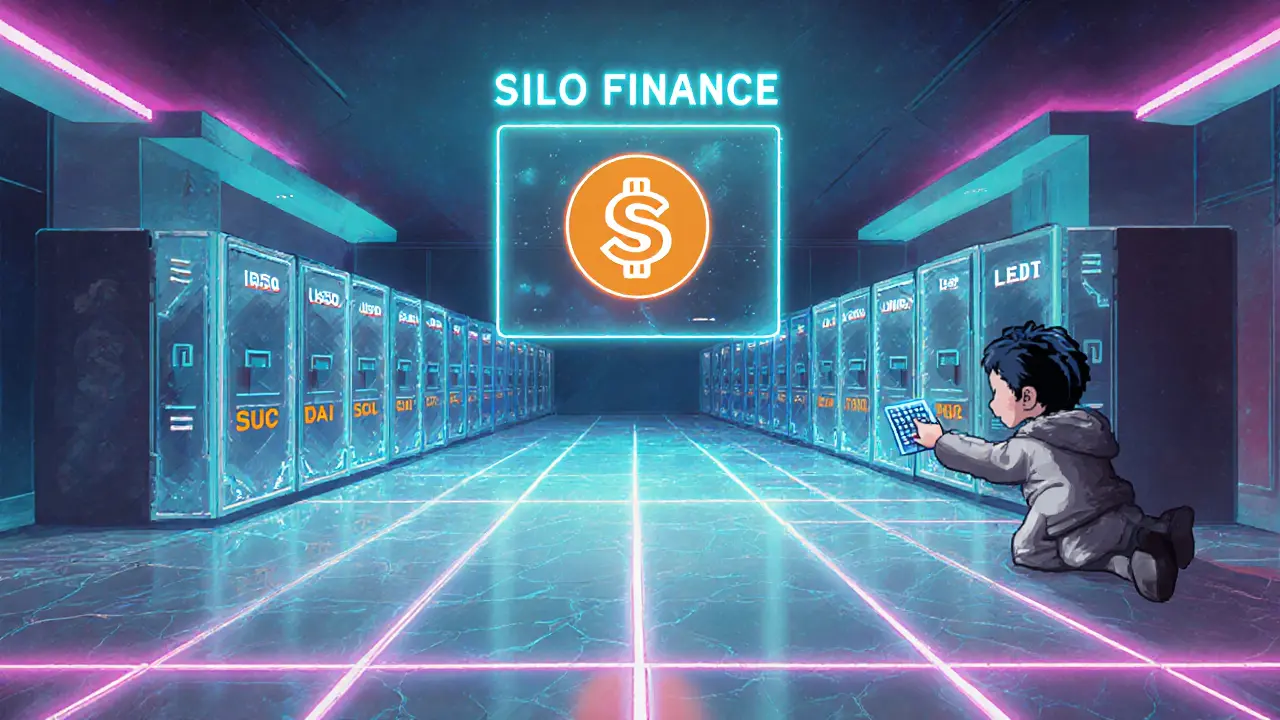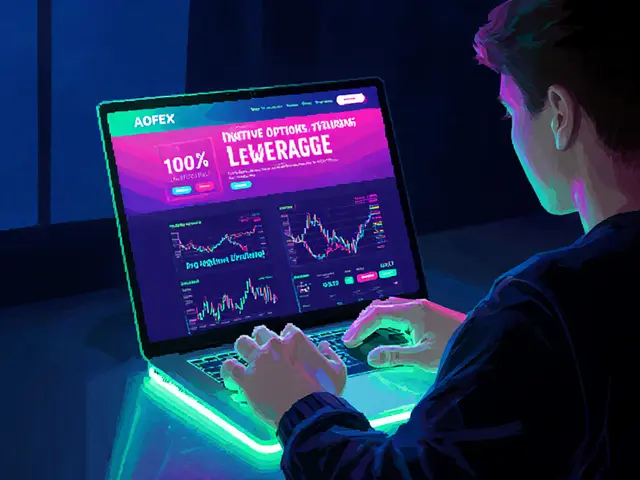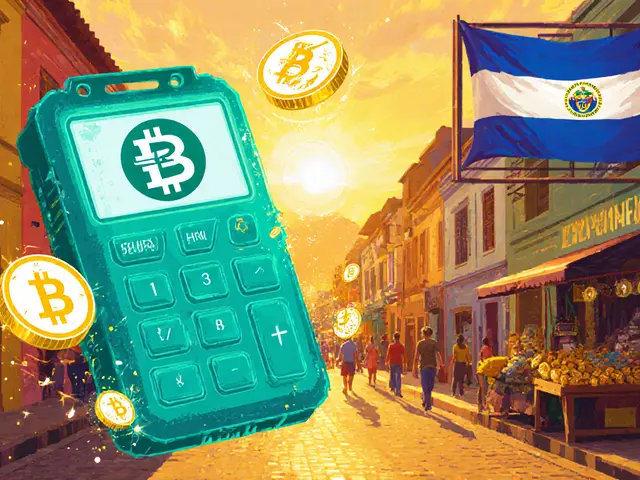Silo Finance Risk Isolation Calculator
Risk Analysis Results
With traditional pooled lending, a default risk of 2% could potentially impact $ of your shared pool assets.
In contrast, with Silo Finance's risk isolation, only 0 of your assets would be at risk in case of default, assuming the same default probability.
Imagine a crypto bank where every loan market lives in its own safety‑deposit box, so a default in one market can’t spill over into another. That’s the promise behind SILO crypto coin and the protocol that backs it. If you’ve been watching DeFi for a while, you’ve probably heard the term “silo” tossed around, but you might not know exactly how it works, why it matters, or how you can actually use it. This article breaks down the concept, the tech, the token mechanics, and the practical steps you need to start lending or borrowing on Silo Finance.
Key Takeaways
- Silo Finance creates isolated lending markets called “silos” to protect users from cross‑market contagion.
- The protocol runs on Ethereum, Arbitrum, Avalanche, and Sonic, giving you cross‑chain flexibility.
- SILO is the governance token; staking it yields xSILO, which auto‑compounds protocol fees.
- Risk‑isolation lets borrowers earn yield on collateral while borrowing, boosting capital efficiency.
- Security is reinforced by a $350,000 bounty program and an active DAO that steers upgrades.
What Is Silo Finance?
Silo Finance is a non‑custodial DeFi lending protocol that introduces programmable, risk‑isolated markets - called silos - for borrowing and lending crypto assets. Founded by Aiham Jaabari in 2021, the platform markets itself as a “non‑custodial crypto bank” where each silo operates independently, preventing bad debt in one market from affecting another.
How Does the Risk‑Isolation “Silo” Work?
Traditional DeFi lenders such as Aave or Compound pool all assets into a single market. When a borrower defaults, the loss spreads across every participant. Silo Finance flips that logic. Every asset pair (for example, USDC‑ETH) gets its own silo. The protocol enforces an over‑collateralized loan within that silo, meaning the collateral value always exceeds the borrowed amount. Because each silo is self‑contained, a liquidation in the USDC silo never touches the DAI silo.
The isolation is enforced by smart contracts that keep a strict collateral‑to‑debt ratio per silo. If the ratio falls below the required threshold, an automated liquidation routine sells the collateral only within that silo, preserving the health of the rest of the system.
Who Can Use a Silo?
- Suppliers - Users who deposit tokens into a silo to earn interest and protocol fees.
- Borrowers - Users who lock up collateral in a silo and take out a loan against it, while still earning yield on the locked collateral.
- Vault Managers - Operators of Silo Vaults that auto‑balance liquidity across multiple silos for fee revenue.
- Applications - External protocols (e.g., yield aggregators, DEXes) that integrate with Silo to source or provide liquidity.
Tokenomics: SILO and xSILO
SILO is the native governance token of the Silo Finance protocol. Holders can vote on proposals, adjust interest‑rate parameters, and allocate liquidity gauges. In addition to voting power, SILO can be staked in the protocol’s rewards contract to receive xSILO an auto‑compounding receipt token that represents a share of the protocol’s fee pool.
When you stake SILO, every protocol fee (borrow interest, liquidation penalty, and vault fee) is automatically converted into more xSILO. This mechanism turns passive token holders into active earners without the need for manual compounding.

Multi‑Chain Presence
Silo Finance isn’t locked to a single blockchain. It has live deployments on four major networks:
- Ethereum - the original mainnet where the first silos were launched.
- Arbitrum - an L2 solution that reduces gas fees and speeds up transactions.
- Avalanche - a high‑throughput chain that attracts liquidity‑seeking users.
- Sonic - an emerging EVM‑compatible chain offering low‑cost execution.
Because each silo is a smart contract that can be replicated across chains, users enjoy the same risk‑isolation benefits whether they’re on Ethereum or a cheaper L2.
How Silo Finance Stacks Up Against the Competition
| Feature | Silo Finance | Aave | Compound |
|---|---|---|---|
| Risk isolation per asset pair | Yes - each silo is independent | No - shared liquidity pool | No - shared liquidity pool |
| Cross‑chain deployment | Ethereum, Arbitrum, Avalanche, Sonic | Ethereum, Polygon, Optimism | Ethereum only |
| Yield on collateral while borrowing | Supported via “non‑borrowable mode” | Limited (only on certain assets) | Not available |
| Governance token | SILO (auto‑compounded xSILO) | AAVE | COMP |
| Security bounty program | $350,000 allocated | Ongoing but smaller | Ongoing |
What this tells you is that Silo Finance’s biggest edge is the silo‑based isolation, which dramatically reduces systemic risk compared to the shared‑pool design of Aave and Compound. If you’re risk‑averse or managing a diversified portfolio, that isolation can be a game‑changer.
Security and Governance
Security is enforced on three fronts: code audits, a $350,000 bounty program that rewards white‑hat hunters, and an active DAO governance a decentralized autonomous organization that lets SILO holders propose and vote on protocol upgrades. Proposals range from adjusting collateral ratios to adding new asset pairs. Participation earns extra rewards, creating a self‑reinforcing loop of security and community involvement.
All governance actions are recorded on‑chain, meaning anyone can verify the outcome. The DAO also controls “gauges” that direct liquidity incentives, giving token holders a direct say in where new reward streams flow.
Step‑By‑Step: Getting Started with Silo Finance
- Choose a supported wallet (MetaMask, Rainbow, etc.) and connect it to the network where you want to operate (Ethereum, Arbitrum, Avalanche, or Sonic).
- Navigate to the official UI (the URL is listed in the protocol docs) and select the silo that matches your desired asset pair, e.g., USDC‑ETH.
- To become a supplier, click “Supply”, approve the token spend transaction, and confirm the amount you wish to deposit. Your funds will start earning the silo‑specific interest rate instantly.
- If you prefer to borrow, first supply collateral in the same or another silo, then click “Borrow”. The interface will show the maximum borrowing power based on the over‑collateralization ratio. Confirm the loan transaction.
- Stake any SILO you hold via the “Stake & Earn” tab. After approval, you’ll receive xSILO, which auto‑compounds protocol fees. Track your accumulated rewards on the dashboard.
- Optional: Deploy a Silo Vault if you manage larger capital. Vaults automatically shift liquidity among silos to capture fee opportunities while preserving isolation.
All steps are gas‑optimized on L2s, and the UI shows real‑time TVL and APR numbers pulled from analytics.silo.finance.
Pros, Cons, and Common Pitfalls
- Pros
- Risk isolation protects against contagion.
- Earn yield on collateral while borrowing.
- Cross‑chain flexibility lets you chase the best rates.
- Active DAO gives token holders real influence.
- Cons
- Liquidity per silo can be lower than pooled alternatives, leading to higher slippage on large trades.
- Complexity: new users must understand silo mechanics before committing large sums.
- TVL data is less prominently displayed than on larger platforms, making quick assessment harder.
- Pitfalls to avoid
- Never supply a token to a silo without checking its collateral factor; over‑leveraging can trigger liquidation.
- Watch gas fees on Ethereum; switching to Arbitrum or Avalanche for large moves often saves money.
- Keep an eye on governance proposals; a change in interest rates can affect your APR dramatically.
Frequently Asked Questions
What does “risk‑isolated” mean in practice?
Each silo is a separate smart‑contract market. If a borrower defaults in the USDT silo, only lenders in that silo suffer loss. All other silos remain untouched, so your USDC or DAI exposure stays safe.
Can I earn interest on my collateral while I borrow?
Yes. Silo Finance offers a “non‑borrowable mode” that lets you lock collateral and still collect the silo’s supply APR. This extra yield can offset part of your borrowing cost.
How does xSILO differ from plain SILO?
Staking SILO converts protocol fees into more xSILO automatically. xSILO thus grows over time without you having to claim or reinvest, giving you a compounding return on top of any token‑price appreciation.
Is Silo Finance safe to use on the mainnet?
The protocol has undergone multiple audits, runs a $350,000 bounty program, and its code is open‑source. While no system is 100% risk‑free, the layered security approach and isolated silos reduce systemic risk compared to shared‑pool lenders.
Do I need to hold SILO to borrow?
No. Borrowers only need to provide sufficient collateral in a supported token. Holding SILO is optional unless you want to vote on governance or earn xSILO rewards.
Whether you’re a DeFi veteran looking for a safer way to diversify your lending portfolio, or a newer crypto enthusiast who wants to experiment with borrowing against yield‑earning assets, Silo Finance offers a fresh toolbox built around risk isolation. By understanding the mechanics, picking the right chain, and staying engaged with the DAO, you can tap into higher yields while keeping your exposure under control.








Oreoluwa Towoju
June 20, 2025 AT 19:15If you’re new to Silo Finance, start by picking a single silo on a low‑fee chain like Arbitrum, supply a modest amount of USDC, and watch the APR before scaling up.
Jason Brittin
June 24, 2025 AT 20:28Nice and simple, but you could also just dump a gazillion dollars in there and hope for the best 😂. Still, taking it slow never hurt anyone.
Amie Wilensky
June 28, 2025 AT 21:42While the previous advice sounds charming, one must, however, recognize that the protocol’s underlying smart contracts, despite their elegance, are not impervious to bugs; audits can miss edge‑cases, and the bounty program, though generous, does not guarantee immediate remediation; consequently, a casual user might find themselves exposed to unforeseen risks, especially if they ignore the importance of collateral ratios, and that, frankly, is a reckless approach.
MD Razu
July 2, 2025 AT 22:55The concept of risk isolation in DeFi, as embodied by Silo Finance, invites us to reconsider the very foundations of how credit risk propagates through blockchain ecosystems.
When you isolate each asset pair into its own smart contract, you effectively create firewalls that prevent a single default from igniting a cascade of liquidation events.
This architectural decision mirrors traditional banking's practice of compartmentalizing loan portfolios, yet it does so without any central authority.
From a technical standpoint, the over‑collateralization ratio acts as a quantitative safeguard, ensuring that the value of locked collateral always exceeds the borrowed amount.
If market volatility pushes the ratio below the predetermined threshold, an automated liquidation routine is triggered within that silo alone.
Consequently, lenders in unrelated silos remain untouched, preserving capital and maintaining confidence across the broader protocol.
Moreover, the ability to earn yield on the collateral while borrowing introduces a capital‑efficiency premium absent in many legacy lending platforms.
Users who understand this dual‑earning mechanism can effectively amplify their returns without proportionally increasing exposure.
However, the trade‑off lies in liquidity depth; isolated silos often house smaller pools, which can lead to higher slippage for large trades.
Navigating this landscape therefore requires a strategic balance between risk mitigation and liquidity access.
Cross‑chain deployment further complicates the picture, as each network brings its own fee structure and transaction finality characteristics.
Arbitrum, for instance, offers lower gas costs, making it attractive for high‑frequency borrowers, while Ethereum provides the broadest asset coverage.
The governance token, SILO, and its auto‑compounding derivative, xSILO, serve to align incentives, rewarding participants who stake and vote on protocol parameters.
Active participation in the DAO can shape interest‑rate models, collateral factors, and the introduction of new silos, thereby influencing the protocol’s risk profile.
In summary, Silo Finance’s risk‑isolation paradigm represents a thoughtful evolution in DeFi lending, offering a nuanced blend of safety, efficiency, and community governance.
Charles Banks Jr.
July 7, 2025 AT 00:08Oh great, another essay on risk isolation-just what the internet needed. I guess we’ll all become risk‑averse monks now.
Ben Dwyer
July 11, 2025 AT 01:22Take it step by step; monitor your collateral health dashboard daily, and you’ll build confidence without over‑extending.
Lindsay Miller
July 15, 2025 AT 02:35Understanding how each silo works can feel overwhelming, but remember that every expert started with a single transaction.
Katrinka Scribner
July 19, 2025 AT 03:48Totally get ya 😅! Just start small, maybe 10 USDC, and watch how the platform feels. If it looks good, you can add more later 👍.
VICKIE MALBRUE
July 23, 2025 AT 05:02Stay curious and the yields will follow.
Waynne Kilian
July 27, 2025 AT 06:15Exactly, curiosity paired with caution is the best combo for sustainable gains.
Naomi Snelling
July 31, 2025 AT 07:28Some say the real profit comes from the hidden contracts they never disclose, and the DAO might be a front for a larger entity.
Michael Wilkinson
August 4, 2025 AT 08:42That’s a stretch-there’s no evidence beyond speculation, and the audits are publicly available for anyone to review.
Billy Krzemien
August 8, 2025 AT 09:55Review the audit reports on GitHub, compare the fee structures across chains, and set your risk parameters accordingly for a balanced strategy.
april harper
August 12, 2025 AT 11:08Alas, the allure of immaculate safety often blinds us to the lurking complexities beneath the veneer of decentralized finance.
Clint Barnett
August 16, 2025 AT 12:22Imagine, if you will, the vibrant tapestry of lending markets, each thread a silo shimmering with its own promise of insulated security; the sheer elegance of such modular design sparks a chorus of admiration among the DeFi avant‑garde. Yet, beneath that kaleidoscopic facade lies the gritty reality of liquidity scarcity, where each silo must summon its own pool of brave capitalists to keep the gears turning. The dance between risk mitigation and capital efficiency becomes a delicate waltz, demanding that participants not only understand the mathematics but also the poetry of over‑collateralization. When you stake SILO and watch xSILO blossom, you’re witnessing a compounding symphony that rewards patience as much as acumen. However, the cadence can falter if the market swings violently, and a mis‑calculated leveraging move may turn the music into cacophony. Therefore, the prudent explorer charts a course that balances ambition with humility, setting stop‑loss thresholds and diversifying across chains. The cross‑chain bridges, while unlocking new horizons, also introduce subtle frictions that can erode returns if ignored. In the end, the journey through Silo Finance is less a sprint and more a pilgrimage, where each step is measured, each decision weighed, and every reward savored like a fine vintage. Embrace the complexity, cherish the isolation, and let the decentralized chorus guide your next move.
Jacob Anderson
August 20, 2025 AT 13:35Sure, because the next big thing is always “isolated lending” – said no one who actually reads the fine print.